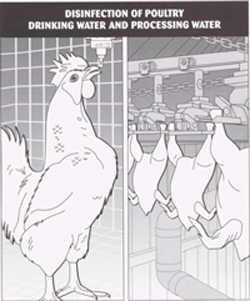Disinfection Of Poultry Drinking Water And Processing Water
General
 Chlorine disinfection has been used in poultry processing plants for many years. It's a proven fact that properly chlorinated processing water including carcass wash water, chilling water, assembly line spray water and equipment washdown water provides a tremendous increase in product shelf life which translates to increased product salability and profitability.
Chlorine disinfection has been used in poultry processing plants for many years. It's a proven fact that properly chlorinated processing water including carcass wash water, chilling water, assembly line spray water and equipment washdown water provides a tremendous increase in product shelf life which translates to increased product salability and profitability.
The one thing disinfection in the poultry processing plant can't do, is assure that only birds of the highest quality and health are delivered to the processing plant. It's up to the farms that grow the poultry to provide top quality product to the processing plant. Once again, "chlorine to the rescue". Proper disinfectionof the poultry drinking water supply will control the diseases usually found in poultry houses and will result in increased body weight and better egg production which again results in heightened profits.
In a poultry house application, bacteria can grow rapidly in poultry house drinkers, even if the source water is bacteria free. Diseases such as fowl cholera often pass from bird to bird via the drinking water. Also, drinkers that are contaminated with feed and manure provide an excellent environment for the growth of E. coli, a coliform bacteria which indicates the presence of fecal contamination. Maintaining an adequate level of chlorine in the drinkers can greatly reduce the numbers of bacteria present.
The chlorine applied should be in the form of Free Available Chlorine since HOCL (Hypochlorous Acid) is the most effective form of chlorine at destroying bacteria. The chlorina application should also be continuous as the water in thedrinkers is constantly being contaminated with feed, manure, mucus, and saliva from the birds. A free chlorine residual level should exist in the drinker farthest from the source of chlorine to assure that disinfection is adequate. Flushing the water lines thoroughly between flocks and regular cleaning of the drinkers and drinking water apparatuses will minimize the amount of chlorine required while maximizing its effectiveness. The chlorination system is turned off whenever the birds are being medicated.
DISINFECTION OF POULTRY PROCESSING WATERS
General
Properly disinfected poultry drinking water helps to assure a high quality product is delivered to the processing plant. After arrival at the processing plant, and during the various processing procedures, it's important to make sure outside microbial contamination of the poultry does not occur. For instance, properly disinfected spray water can be utilized to wash off fecal and other physical contaminants while reducing bacterial levels on the carcasses.
The processing of the poultry and the proper disinfection of the processing waters is extremely involved. The poultry passes through many different pieces of equipment and goes through numerous operations. Along with proper disinfection of the poultry, the disinfection process must also keep the equipment (which is an ideal breeding ground for bacteria) and the personnel involved, properly sanitized at all times. This will assure the longest possible shelf life of the product which translates to increased product salability and profitability.
Processing
Processing procedures may differ slightly from one processing plant to another however the basic steps involved generally include the following operations. Each step or operation will use properly chlorinated flowing water and/or spray water.
- 1. The birds (product) are slaughtered and hung on a conveyor line where they pass through an area or tunnel which provides sufficient time to completely drain the blood.
2. The product next enters a series of tanks containing recirculating hot (scald) water after which they pass through specialized machinery which removes most of the feathers. Additional removal of feathers and hair may be done by hand as well.
3. The product next goes to singeing machinery which removes the remainder of feathers and hair.
4. The carcasses are next thoroughly washed and disinfected on the outside to remove all possible contaminants, then passed into an eviscerating area to remove unwanted internal organs. Some internal organs such as the liver and gizzard are saved and receive additional processing which again will use properly chlorinated water.
5. The carcasses are next inspected for disease. Product that is free of disease is again thoroughly disinfected both inside and out with properly chlorinated water.
6. The final step involves passing the product through "chill tanks" which lowers the temperature of the product to approximately 35°F. After the chill tanks, the product is hung to dry, them packed in ice for shipment.
Provided by: Chlorinators Incorporated
